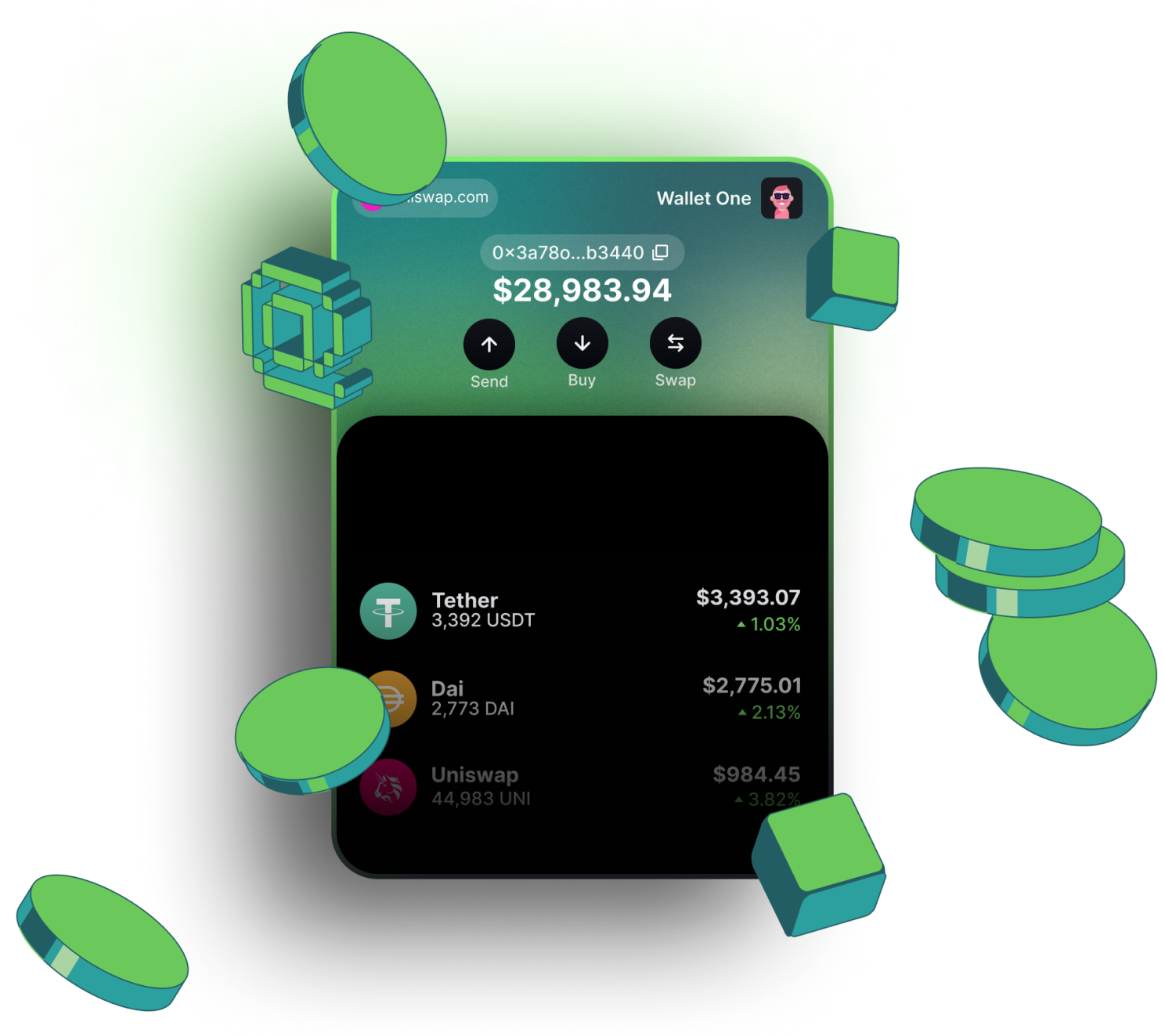Wigwam is the best  Beam blockchain crypto wallet
Beam blockchain crypto wallet
Download Extension
Why choose the Wigwam crypto app?
Work with Beam Testnets and Mainet
Buy Beam tokens, including native token, by using a credit card
Swap Beam-based tokens directly in the wallet
Possibility to connect the wallet to all Beam Network dAps: DeFi, DAO, Gamings, etc
How to get a Beam address in Wigwam web wallet
Create a wallet in Wigwam
Choose a Beam network from the dropdown menu
Copy you Beam address
Beam Blockchain Review
Beam blockchain is a privacy-focused network that delivers scalable and confidential transactions without storing transaction history or wallet addresses on the public ledger. It keeps this information locally on users' devices, giving them complete privacy control and allowing selective sharing of personal details within the network.
Origin and Vision
In 2018, Alexander Zeidelsen and a team of developers introduced the Beam blockchain to enhance anonymity and user privacy in the crypto space. It utilized two protocols: Mimblewimble, ensuring confidential transactions without disclosing the amount, or identity of the sender and receiver, and LelantusMW, allowing users to generate and burn anonymous coins. These protocols ensure secure transactions while maintaining privacy, making Beam the preferred choice for those seeking private digital asset transactions.
Key Milestones
In 2019, the Beam blockchain introduced its first mainnet version to enhance confidentiality and provide users with personal data security that ensured sensitive details like wallet addresses and transaction history remain private.
After subsequent updates, two years later, Beam blockchain released version 6.0 Fierce Fermion that introduced the Beam Virtual Machine (BVM) for creating Smart Contracts (Shaders). It turned Beam into a complete confidential DeFi network by supporting various DeFi use cases like lending, AMM pools, and enabled the emission of new Confidential Assets. Also, it provided users with the tools to build and deploy new dApps integrated into Beam Wallets.
What Consensus Algorithm Does Beam Blockchain Use?
Beam uses a Proof-of-Work consensus algorithm called BeamHash III to ensure network security, stability, and users' privacy. It operates on nodes with two modes: Mining and Validating.
Validators maintain a complete record of the chain, creating and validating blocks and transactions to preserve network integrity. These nodes function as Dandelion Stem relays to enhance P2P security, enabling wallet-to-wallet communication via SBBS messages, and improving blocks and transactions flow across the Beam network. Miners mine BEAM tokens to improve network security. They’ll earn rewards of 80 coins per block in the first year, 40 coins per block in years 2–5, and 25 coins in year six. Rewards will halve every four years until year 129, and Beam emission stops after year 133.
To set up a Beam node, visit the official Beam website to download the wallet. Create or restore your wallet using a seed phrase and stake a minimum of 16 Beams. Configure your node settings within the wallet and start the Beam Node via the interface to engage in mining or validating network transactions.
How Beam Technically Solved Problems with Scalability, Decentralization, and Speed?
The Beam blockchain tackled scalability, speed, and decentralization using the BeamHash III Proof-of-Work consensus algorithm. Validators play a key role in scalability by validating blocks and transactions. Using the Mimblewimble protocol, the network combines multiple transactions into a single block, reducing data storage on the chain for efficient transaction processing.
Beam involves its community in decision-making. Users can vote on proposed policy changes and ecosystem-related proposals, fostering a decentralized approach within the Beam blockchain.
DeFi Ecosystem on Beam
In 2020, Beam introduced BeamX, a DeFi layer with integrated smart contract capabilities on the Beam blockchain. It established a privacy-focused DeFi ecosystem using the BEAMX token and governed by the BeamX DAO, emphasizing privacy and confidentiality.
In 2023, the Beam blockchain launched Beam DEX, enabling fast, private, and affordable token exchanges. Operating at an average speed of 17 TPS via the high-frequency transactions (HFTX) mechanism, it offers swift and low-cost transactions, requiring only 1 $BEAM for over 800 token swaps. You may use the Wigwam DeFi wallet to join the Beam DeFi ecosystem.
Beam NFT Marketplaces
In 2021, the Beam network launched an NFT Gallery, a secure marketplace for confidentially transferring and storing unique digital assets. Users can bring NFTs from any EMV-compatible blockchain, like Avalanche or Ethereum, for private storage and transfers on the Beam blockchain. Also, BeamNFTart is a community-created NFT marketplace for exploring, collecting, and trading non-fungible tokens.
Tokenomics of the BEAM token and Gas Usage on Beam
The use cases of the BEAM token includes the following:
- Transaction Fees: BEAM holders use the coin to cover transaction fees within the Beam ecosystem
- Governance: BEAM token holders can engage in the network security by contributing to the ecosystem decision-making processes and voting on proposed policy proposals and changes within Beam Privacy.
- Miners’ incentives: Within the Beam network, BEAM serves to incentivize miners through block rewards and transaction fees for ensuring security.
- Staking: BEAM token holders can stake their tokens to secure the network and participate in validation processes for rewards in the Beam DEX and BeamX DAO ecosystem. The minimum staking requirement is 16 Beams, and rewards are based on the amount staked.
- Private Transactions: BEAM holders can easily perform private network transactions without revealing details about the sender, receiver, or the amount involved.
- Tokenization: BEAM empowers users to tokenize real-world assets like property, stocks, or commodities on the blockchain, ensuring confidentiality throughout the process.
FAQ
Users pay gas fees on this blockchain using the BEAM token.
Effortlessly monitor Beam wallet activities via blockchain explorers and user-friendly options include Beam Privacy Community Explorer and Beam Block Explorer. Beam Privacy Community Explorer provides information on BEAM price, market cap, latest transactions, blocks, and atomic swaps.
Beam Block Explorer provides information about transactions, tokens, prices, hashrate charts, and node activities.
The best crypto wallets for the Beam blockchain includes the following:
- Wigwam Web3 wallet
- Beam Wallet
- TokenPocket Wallet
- MetaMask Wallet.
Install the MetaMask app, set up your wallet, and go to settings. Click on Networks, choose "Add Network," and then select “Add a Network manually” at the bottom of the page. Enter the Network Name, RPC URL, Blockchain Explorer, Chain ID, and Currency Symbol details. Save the settings, and you have successfully added the Beam blockchain to MetaMask.
Go to your wallet, click on your profile at the top-right, and select "Settings" from the Popular projects on the Beam blockchain cover DeFi and NFTs. BeamX and Beam DEX are in the DeFi category, while NFT Gallery and BeamNFTart are well-known NFT platforms.





